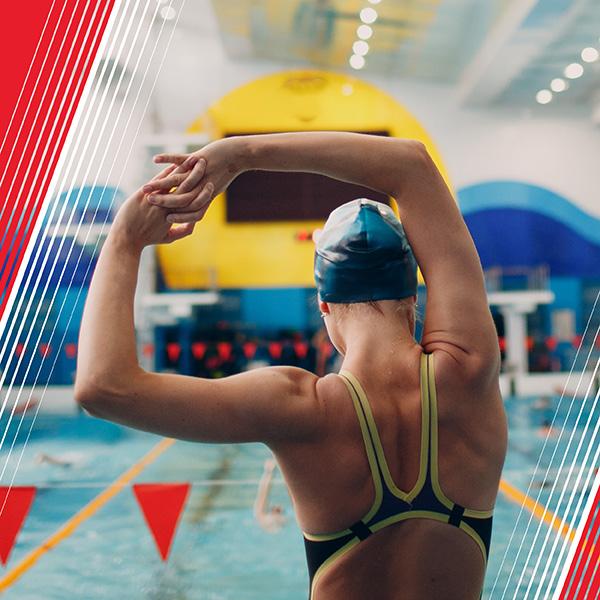SWIMMER'S SHOULDER TREATMENT SWIMMER’S SHOULDER EXERCISES & STRETCHES

With outdoor pools open for the summer, swimmers and exercise enthusiasts are hitting the swimming lanes. The benefits of swimming are no secret — swimming provides a well-rounded workout, cools the body and burns calories. It’s also known for its low impact on the joints, but there is one joint that may become irritated in those who swim frequently: the shoulder.
Swimming, or any sport or profession that requires repetitive overhead motions, increases the risk of shoulder impingement, a condition better known as swimmer’s shoulder. When the shoulder is overused, irritated or injured, the rotator cuff (a group of muscles in the shoulder) swells and rubs against the bone. The rubbing can cause severe discomfort even when the shoulder is at rest, and the pain only increases with continued use.
Swimmer’s shoulder can be a serious condition, but don’t let it deter you from jumping in the pool for a workout! Swimmer’s shoulder treatment consists of education, swimmer’s shoulder exercises, stretching and physical therapy; all of which can effectively prevent or treat shoulder impingement.
Symptoms and Causes of Swimmer's Shoulder
Shoulder impingement has a number of causes, such as:
- Overuse of the shoulder
- Improper form or poor stroke mechanics
- Previous shoulder injury
Swimmer’s shoulder may be confused for soreness, leading some athletes to delay treatment. Without treatment, symptoms can worsen and the damage to the shoulder can become more severe. Look out for the following symptoms when considering the possibility of swimmer’s shoulder:
- Pain when reaching arms overhead or behind back
- Weakness in the shoulder
- Decreased range of motion
- Shoulder stiffness
- Swelling or tenderness in the shoulder
Experiencing different shoulder symptoms? Learn more about shoulder injuries.
Treating Swimmer’s Shoulder
Fortunately, swimmer’s shoulder treatment tends to be nonsurgical. In minor cases, swimmers can complete stretches and swimmer’s shoulder exercises at home to help alleviate the discomfort. For more serious or prolonged cases, the most effective option for treatment is physical therapy, an approach that incorporates both stretching and strengthening exercises.
Stretches for Swimmers
Stretching in preparation for a workout is imperative when it comes to preventing injury. Swimmer stretches help to warm up the muscles and prepare the body for movement. Try these swimmer stretches before getting in the water:
- Wall Press
- Cross Arm Stretch
- Thread the Needle
- Doorway Pec Stretch
- Tricep Stretch
- Child’s Pose
- Open Book
- Behind Back Lock Stretch
At-Home Swimmer’s Shoulder Treatment
Discomfort from shoulder impingement is from inflammation, so anti-inflammatory measures will help to decrease pain. Apply ice to the shoulder 20-30 minutes after exercising, or take anti-inflammatory medicine to reduce swelling.
Sports Physical Therapy
Through strengthening exercises, effective stretches and massaging, physical therapists can help athletes not only recover from shoulder impingement, but also prevent future injury. PTs will also provide the necessary education, such as tips for better form, to facilitate future success in your sport. Physical therapy can also improve range of motion and flexibility, two factors that impact swimmers’ performance.
ATI Sports Medicine athletic trainers are skilled in treating a variety of athlete injuries, such as rotator cuff injuries, dislocations and sprains. If you are ready to begin the road to recovery, you can schedule a free consultation at ATI. In 15 minutes, a therapist will evaluate your injury, give actionable tips and provide a plan for care.
Prevention of Swimmer’s Shoulder
Evaluate Your Form
Poor swimming mechanics can lead to injury. Revisit your form — are you extending your arm to maximum length? Is your body rolling too little or too much? If you are weaker at a certain stroke, do some research to make sure you are using the proper technique. Your body will thank you for it! Physical therapists can also provide specific tips on how to improve your form.
Rest Plays a Role in Prevention
It may be necessary to take a break from swimming and physical activity. Swimmer’s shoulder is, after all, an overuse injury, so giving the body time off will expedite the healing process. If you feel pain in your shoulder, rest for 24-48 hours to allow swelling to go down.
Recover from Sports Injuries with ATI
ATI Sports Medicine athletic trainers work with athletes at all levels of competition to prevent, evaluate and treat sports injuries through physical therapy. If you are experiencing swimmer’s shoulder or other bodily pain due to a sport, don’t delay swimmer's shoulder treatment. Schedule a free consultation to get back to the activities that are important to you.
